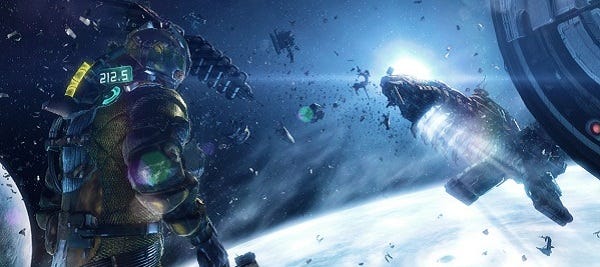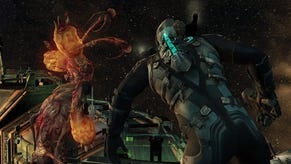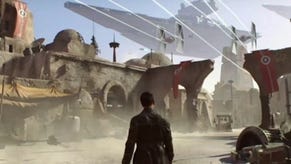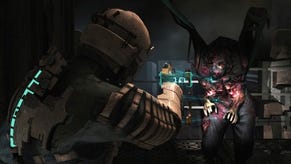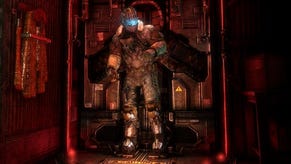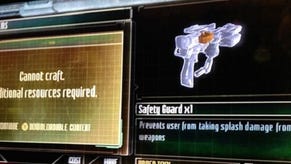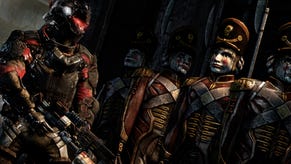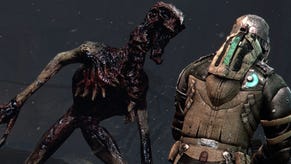Wot I Think: Dead Space 3
The Limbless And Clarke Expedition
Even if Dead Space 3 actively carved off your limbs as you played, some might argue it is the best option in the current vent-bursting alien-blasting market. Don't worry about that though, because I've finished the single player campaign without losing an arm or a leg, and I'm notoriously puny. With nothing to fear but the absence of fear itself, I reacquainted myself with Isaac Clarke and took a winter vacation.
If I were to compare Dead Space’s claustrophobic catacomb-ship to the Nostromo and the more gun-happy Isaac of the second game to a pissed off space marine, I’d be making two hugely imperfect analogies. What a way to start. There is a kernel of truth in the identification of Dead Space 1 with Alien and its sequel with Cameron’s xeno-war but while Isaac’s silence in the first game and the greater sense of isolation were more conducive to terror, and Dead Space 2 certainly ramped up the action and bombastic set pieces. There was a moment early in the third game, as somebody guffed about the Makers and their mythology, that I thought, ‘oh, blimey crikey – they’ve jumped straight to Prometheus’.
It was a moment of cold realisation. Colder than the snowball of a planet that has inexplicably dominated pre-release footage. It was also almost entirely unwarranted.
While the narrative does stumble through an awkwardly inserted love triangle that introduces the wrong sort of tension, Visceral have an ace up their sleeve in the storytelling department and it’s one that reminded me of Portal 2. There are no comedy potatoes and Stephen Merchant doesn’t make an appearance as a gangly necromorph, but just as the journey through Aperture’s history was a sort of narrative archaeology, Dead Space 3’s lengthy final act involves the metaphorical and literal excavation of older stories, both personal and cosmic. The landscapes bring The Mountains of Madness to mind, even if the horror is short-lived rather than eternal.
This is not a horror game. There are countless memories of horror but Isaac is a changed man, more hardened than in his second adventure and resigned to fighting the threats that plague him. He’s also coping much better with the hallucinations, even if he does look like he hasn’t slept for twenty years or so. With the prologue out of the way, we drop in on him in his scuzzy apartment. Isaac is a scruffy, washed-up urchin living in a lunar colony. This is not a horror game. It’s pulp science fiction that happens to take place in a world packed with flimsy-limbed monstrosities.
Dead Space has captured the industrial, blue-collar rust of space well since the first desolate dismember-fest. The design of the Ishimura is powerful not only because it is a labyrinth mausoleum but because it is also, at least in part, a credible craft. Advertisements and advisory posters add detail to the world that technical prowess cannot paint alone, particularly when those details remind that there are other worlds drifting out there in space. Now that Isaac is an engine of war rather than an engineer, Visceral wisely rely on the lives and deaths of the previous inhabitants of Tau Volantis to remind players of the minutiae of human existence at the harshest of future-frontiers. The best of those stories are in the game’s second half, and while some of them are told in the time-honoured form of voice and text logs, others are in easily overlooked tableaus. The environment is not only impressively rendered, but thick with detail and memorable imagery.
I’ll spend some time whining about the changes to combat and the annoyances of the crafting system and its ATMentality in a couple of paragraphs, but it would be as grotesquely unfair as some of the surprise balloon-animal vent ejaculations that the series so loves not to acknowledge the sense of awe that the best moments inspire in the sci-fi nerd region of my brain.
One sequence has Isaac jetting between the ruined ships in an ancient flotilla seeking parts for salvage. I wish it had lasted longer. I wish it was the basis for an entire beautiful, quiet game, but even in the rare moments when it turns the volume up to eleven and dials user control down to ‘PUSH THIS BUTTON’, Dead Space 3 is, more often than not, spectacular. When the blockbusting muscles that power the game flex to their full vein-wriggled extent, they create some of the most impressive visions of the calamitous comeliness that fills the fictional spaces between stars as I’ve ever seen on a screen.
When Isaac isn’t repairing ships and exploring colonies and the cosmos, he’s indulging in his two favourite pastimes: stomping and shooting. Dead Space 2 brought new necromorphs to the flesh-feast to great effect, but the third game is less generous, recycling many in slightly new forms and adding less entertaining human targets instead. Ideally, fighting people, with their guns and their gung-ho, would require a change in tactics, from strategic dismemberment to headshots and hunkering in cover, but they fall apart under boot and bullet just like everything else. Dismemberment is less important throughout the game, in fact. I barely used the plasma cutter, which was my dearest friend throughout Isaac’s previous jaunts, opting instead for a customised shotgun with a spear-lobbing secondary fire.
I built that gun and, admittedly, I was incredibly proud that I had. Crafting seems complex at first but is deceptively simple. A primary unit provides a primary firing mechanism and a secondary unit provides a secondary function, such as the plasma cutter’s swivelling beam or perhaps a grenade launcher riveted to the underside of a tesla cannon. Parts can be found or constructed and it’s in the construction that the microtransactions claw their way through the barricades and flail about making a bit of a mess of things.
They don’t cripple the crafting system – they don’t even scar it significantly, but they exist and they segregate the more exciting blueprints, reserving them for the patient plunderers, or the impatient profligate. I didn’t feel the need to use them on the hardest of the initial difficulty settings, even though I was often several hundred pieces of loot short of a tempting weapon. Incremental shotgun upgrades did the trick, with circuit boards found throughout the story adding simple stat boosts. This is the easiest of the three games so grinding or spending aren’t essential to progress, but with so many weapon types available to experiment with, it is irritating that so many are locked behind a wall of time and extra payment.
It’s also slightly irritating that losing the emphasis on dismemberment has bled the series of some of its personality. Only in the world of games and serial killers could dismemberment be an aspect of ‘personality, but there it is. I miss the days when necromorphs were a little more resilient. The crusty old creatures on Not-Lost-Planet seem all too keen to crumble when a blast hits them in the torso, which is a shame because I like slicing their bits off. It’s still a viable tactic but the mighty shotgun, tearing through every part at the same time, is much more effective and, with all ammo fit for purpose in any gun, there’s no need to conserve specific munitions.
The imposed limits of the crafting system and the one size fits all ammo meant that I never had to switch weapons. Occasionally I’d stick some spare parts together, but I usually ended up with something that looked like a cross between a stapler and an iPhone so I gave up and stuck with the boomstick that I knew so well. All of that combat-witter probably looks like griping and it most certainly is, but I should stress that I still took satisfaction in the vast majority of the twenty-odd hours I spent dismantling beasties.
(A quick note on co-op – I’ve played a little. The single player game doesn’t feel the lack of a co-operative partner and there’s no Resident Evil 5 nonsense, with the AI playing the part of a clumsy friend. There are optional missions throughout the game, all of which I’d recommend partaking in, not particularly for the reward but for the experience as they mostly provide content on a level with the rest of the game. Some of these are co-op only and I am strongly tempted to play through again to try them out.)
In recent years, Dead Space is the big budget franchise I’ve most happily dipped my itchy fingers and whitening knuckles into. Occasionally it hits a dull note, particularly in the too-long middle chapters that become repetitious slogs of savagery and snow, but for the most part, it offers spectacle and even surprise. The latter is rarely tied to the action, but in the sights and sounds. And what sounds. Both music and effects are top notch.
If there were more quiet moments, more locations and more care in the characterisation, I’d have no qualms in recommending Dead Space 3 wholeheartedly. As it is, it’s a game of wonderful sights, not all of which are gruesome, that is occasionally bogged down in the repetitive nature of the combat at its core. Yet in spite of all my pre-release concerns, I’ve still found it be a hugely accomplished and sizable spectacle of world-building and monster-bashing.
The port is, as promised/threatened, without a bell or a whistle. It's a handsome game though and ran as smoothly as butter spread on ice. I opted for joypad controls but mouse and keyboard, for the brief time I tried it, seemed fine, even though the intentional sludginess of the scheme doesn't seem particularly well suited.
Dead Space 3 is available now.
